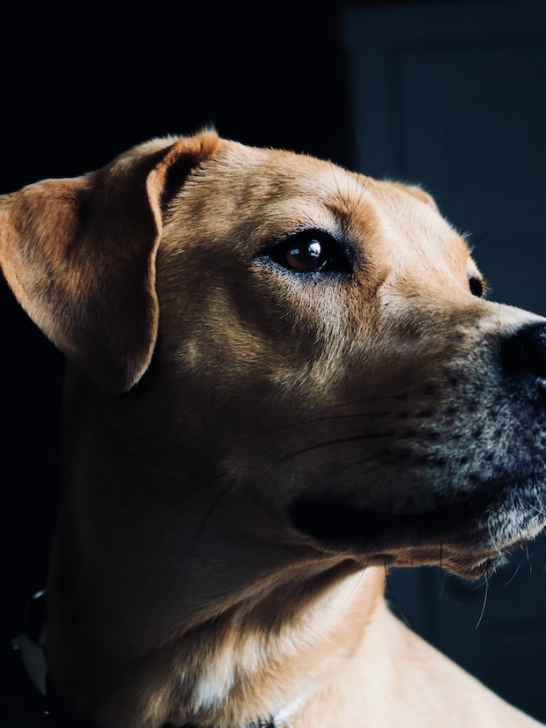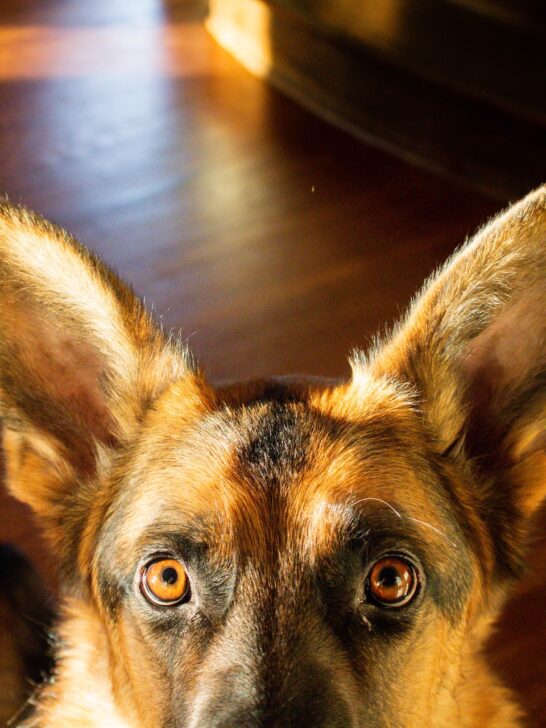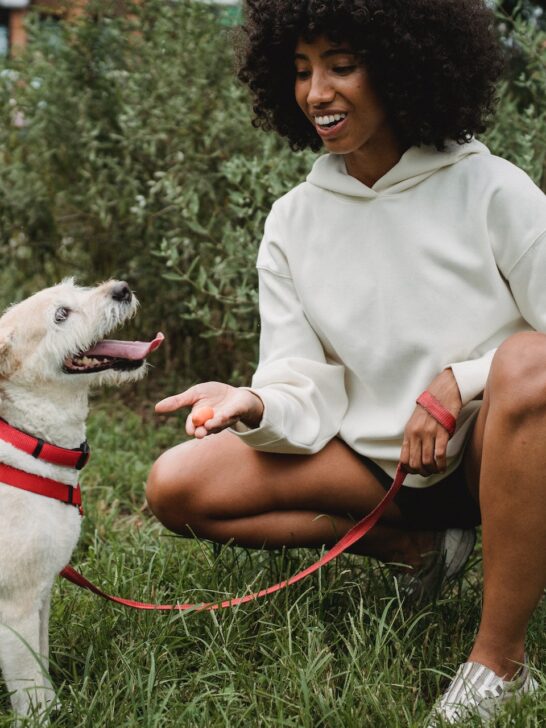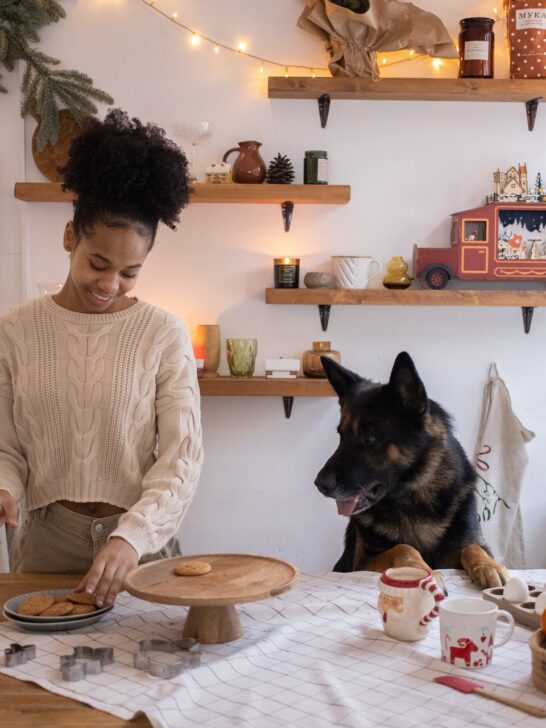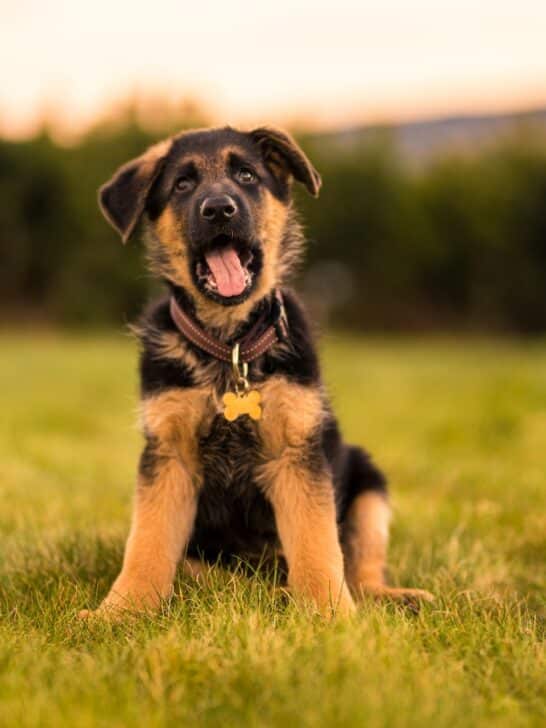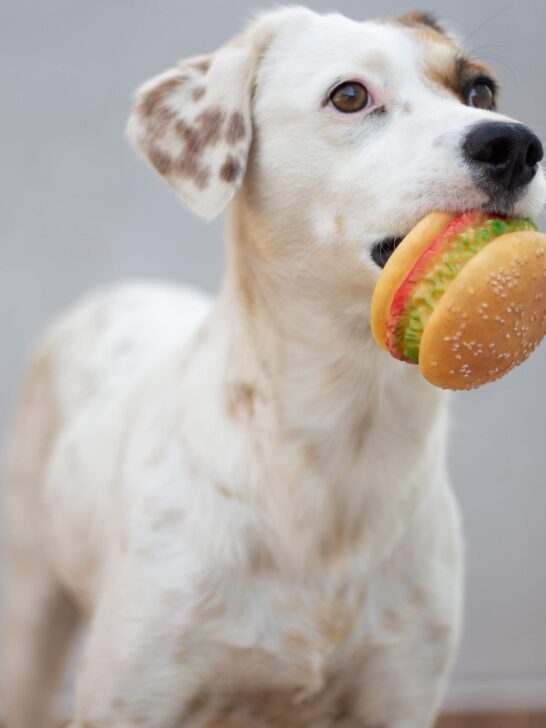German Shepherds in Heat: The Ultimate Care Guide
When a German Shepherd is in heat, it means that the female dog is fertile and prepared for breeding. The heat cycle generally happens twice a year for most dogs.
So, we’ve given you a brief explanation of what “in heat” means. But how does it actually work?
Like we said, the heat cycle first begins in a dog’s life when she reaches sexual maturity. This doesn’t mean when the dog is fully grown.
Instead, it indicates when she begins to release more estrogen hormones. This hormone level then drops during the cycle, which then causes the ovaries to release eggs.
As the heat cycle can be complicated for new dog owners, here is an idea of the different stages.
Stages of heat
There are four key stages of a heat cycle in any dog. Unfortunately, it’s not all about keeping an eye on how much she bleeds. If anything, that part of the heat cycle is the tip of the iceberg!
Proestrus stage
The first stage of a heat cycle is known as the proestrus stage. This can last anywhere between 4-20 days, with most dogs averaging about a week.
The signs of a dog entering her proestrus stage are:
- Bloody discharge
Your dog will spend a lot more time licking herself than usual. Keep an eye out for this, and look for any telltale signs of bloody discharge on your floor, bedding, or pillows.
The discharge will usually look like a bright red color, but most of the time your dog will be cleaning it away.
As soon as you notice your dog licking herself and when you see bloody discharge, this is when the heat cycle has begun.
For your peace of mind and to have a general idea of how long her heat cycle will be, mark this in your calendar.
- Enlarged vulva
The quickest way to tell if your dog has entered her heat cycle is to look at the size of her vulva. Sometimes, it’s not easy to tell if your dog is licking away discharge or if she is simply cleaning herself.
If her vulva looks swollen and larger than usual, this is a clear sign of the heat cycle beginning.
In some cases, her teats might swell and her lower abdomen might darken in color. However, this isn’t easy to spot with German Shepherds due to their thick coats, so just look out for her vulva!
Also – frequent urination is a common symptom during this stage.
- Tail tucking
The proestrus stage is where the dog will feel most insecure about herself. For women, you’ll understand this.
Your dog will begin to tuck her tail around her behind, wrapping it close to her vulva.
This is because she is not yet ready for male suitors who might be taking a fancy to her as they smell her from across the park.
- Change in behavior
The dog will be feeling very sorry for herself at this point. She will become clingy, quiet, confused, nervous, or aloof. It’s also common for your dog to lose her appetite.
Estrus stage
This stage is when the actual heat cycle properly begins.
Most people will refer to this part as the only stage of the heat cycle, but it is equally important to be aware of the first, third, and fourth stages to prepare yourself for the estrus stage.
The estrus stage typically lasts between 5-14 days and indicates that your dog is fertile and ready to procreate. The common signs of this stage include:
- Change in discharge color
The bloody discharge in the proestrus stage will turn to a straw-colored, or even clear, discharge.
This is (somewhat selfishly) great, as it means you won’t have to worry about bloody stains everywhere. The change in discharge color usually occurs around the ninth day of the cycle.
- Tail will untuck
After the proestrus stage, the dog’s tail will move away from the tucked position. Instead, it will return to its regular position.
However, in most cases, her tail might turn slightly upright. This is usually an indication of playfulness and, in dog terms, flirting. After all, her tail is no longer shielding her vulva.
- Change in behavior
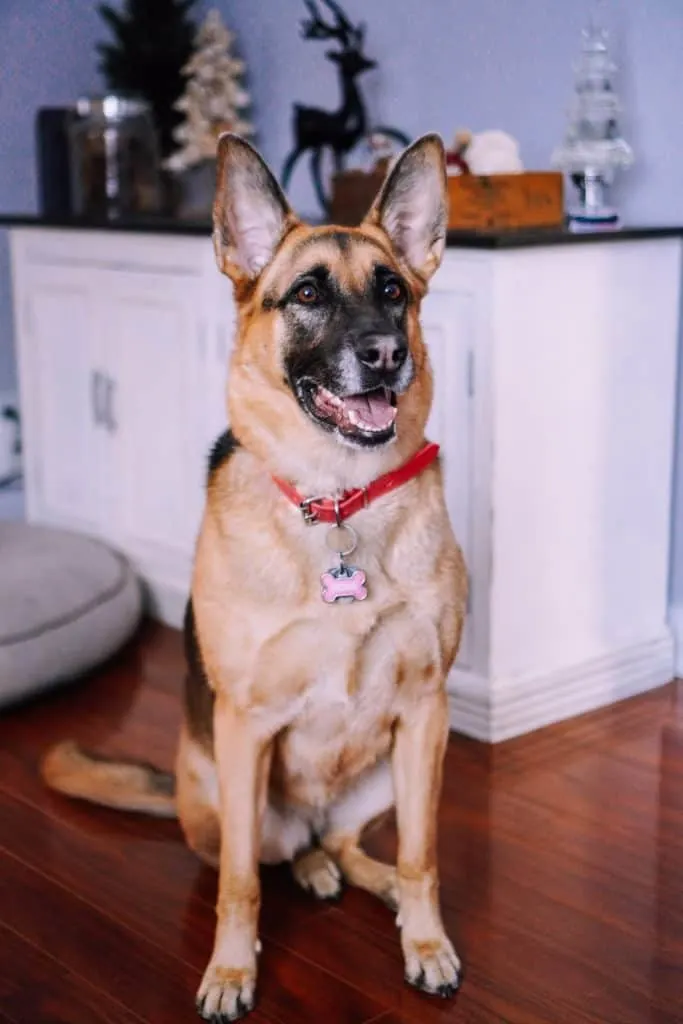
One day she’ll be quiet as anything, the next she will be bouncing around sporadically the minute she senses the presence of a male suitor. She’s got her flirt on.
Her ears might perk upwards in the same way they would if she was wanting to play with another dog – only this time, she’s feeling cheekier than usual.
She will get very creative during this stage. The dog is fully aware of the scent that she is leaving for male suitors, and her heightened senses can smell her potential lovers from a mile off (almost).
She will become suddenly very interested in male dogs, which is why it is essential to keep an eye on her during this time. You don’t want her to go through an accidental pregnancy.
Your dog might still have a loss of appetite or may lose her appetite at this stage. This is normal and won’t last too long!
As this stage is when she is fertile, it is imperative that you make sure she doesn’t mingle with other dogs who might not be neutered.
Your dog won’t be able to tell if a male suitor has been neutered or not – she’ll just want to get the job done. It’s less about the pleasure and more about her natural instincts to breed, remember.
This means that when you take her for walks, it’s wise to keep her on a leash.
It doesn’t matter how obedient she is off the leash, because she could easily get creative and run into someone’s backyard if she gets the smallest sniff of a male suitor.
Also, when a male dog smells the scent of a female in heat – even if it’s the remanence of discharge after you have taken her for a walk – they are likely to act very strangely.
It winds them up, and some male dogs can be more prone to biting when they have been wound up this much. This is another reason why it’s wise to walk your female dog in quiet areas.
If you’re anting to breed from your German Shepherd, now is the time to do so.
This is why it’s so important to keep an eye on her proestrus stage, as it will give you an idea of how long she has until she is fertile.
Make sure to plan the breeding stage properly so the (cough) deed is done in a safe and controlled environment. We’ll leave the rest to your imagination.
Diestrus stage
After all the excitement of the estrus stage, she will enter a 60-90 day period called the diestrus stage.
She will sort of return to similar symptoms of the proestrus stage at this point, where the straw-colored discharge will turn red once again, and she will tuck her tail around her vulva.
She will still carry the scent of the heat, so keep an eye out for male suitors. You should still walk her on a leash for this reason, even if she really wouldn’t be bothered to flirt with a male suitor, anyway.
Her fertility window is over, move on!
Anestrus stage
The final stage indicates when the heat cycle is, at last, over. This is called the anestrus stage, and generally lasts between 60-90 days until she will enter the proestrus stage again.
While it might seem odd to mention this stage as the heat cycle has finished, it’s a key moment to be aware of for those who wish to spay their dog.
A dog cannot be spayed until her heat cycle is definitely over, which is why it’s so important to write down the length of the cycle, so you know when to take her to the vets for the surgery.
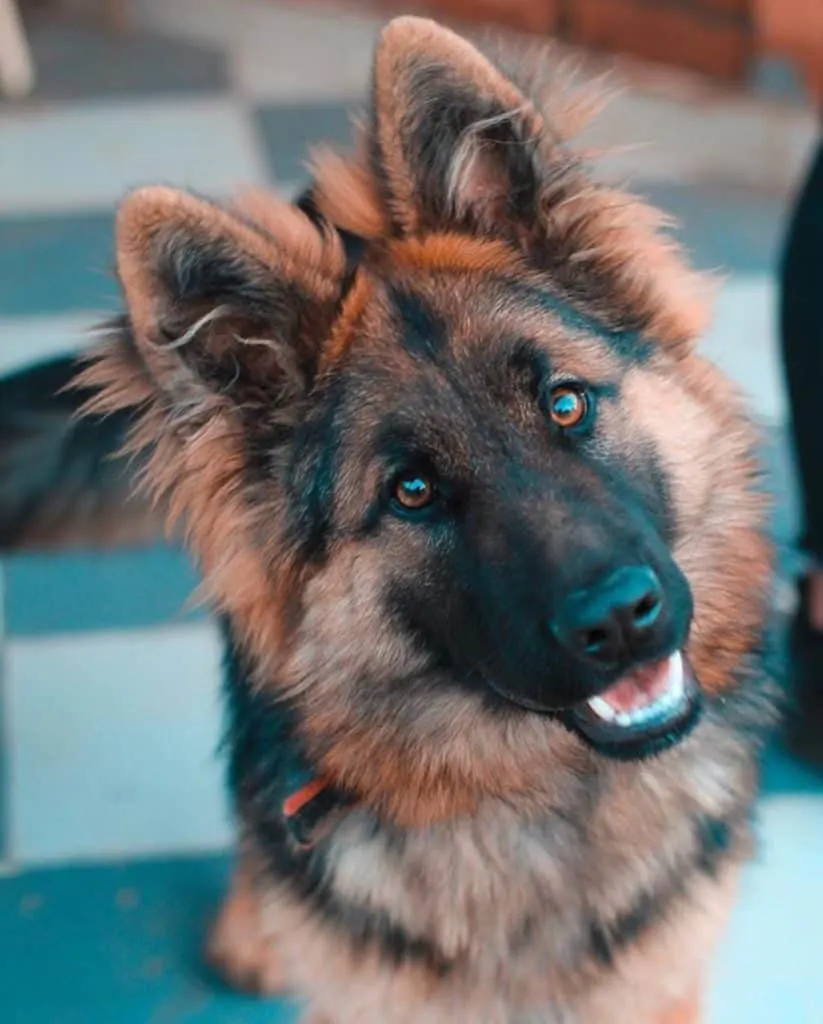
So, how long does the heat cycle last?
The main stage of the heat cycle, as in when she is fertile and ready to mate, usually lasts around 5-14 days. However, the entire cycle lasts up to 6 months.
Remember that the final stage of this cycle is the dormant stage of fertility, so you’ll only need to be on high alert for around 3 weeks.
It all varies from dog to dog. Small dogs are more likely to go into heat twice a year, while large breeds like German Shepherds might only go into heat once a year.
This is completely normal and purely due to the size of the animal.
After all, that’s a large body for estrogen to travel around!
Whether you’re a new dog owner of a German Shepherd or if you’re looking to breed from your dog, figuring out how the dog’s heat cycle works can be quite stressful.
It’s not like a regular human menstrual cycle, after all.
You’ve got the blood to deal with, the hormones, and male dogs sniffing her from afar. It might seem a little daunting to take care of her if you’re choosing not to spay her just yet.
Luckily for you, we’ve got you covered. We know how important it is to understand how the heat cycle works and how to care for your pooch during this time.
Here is the ultimate care guide to German Shepherds in heat!
What does “in heat” mean?
When a dog is “in heat”, it means that they are going through their natural menstrual cycle.
This period of time is often referred to as the “estrus”, as it indicates when estrogen levels rise and the female is ready to mate with males.
Other common nicknames include “in season”, “dog period”, or any other creative names you can think of!
Unlike a human menstrual cycle that lasts between 5-7 days, a dog will be in heat for around 2-4 weeks. The whole cycle itself is a long and drawn-out process that only occurs twice a year.
In most cases, a female dog can enter her first heat cycle at 6-9 months old. Some might even be a year old before they are first in heat.
It mostly depends on the size of the dog, as some will inevitably be much larger than others. They will enter their first heat cycle when they reach sexual maturity.
While the heat cycle is a natural process, there is a safe way to eradicate the fuss about the cycle if you don’t want your dog to procreate. This is called “spaying”.
When a dog has been spayed, her reproductive organs have been removed, so she can no longer reproduce, which stops the heat cycle forever.
What about German Shepherds in heat?
Like every other female unspayed dog, German Shepherds will all go through their heat cycle.
The only difference is that due to their size, this large breed is likely to have to wait a bit longer for their first heat cycle to arrive.
It is always recommended to keep an eye on your female German Shepherd for signs of the estrus cycle from when she reaches 4 months old.
However, it is likely that your dog won’t enter her first cycle until she’s around 1, maybe even 2 years old. This is purely due to the size of the dog and is nothing to worry about.
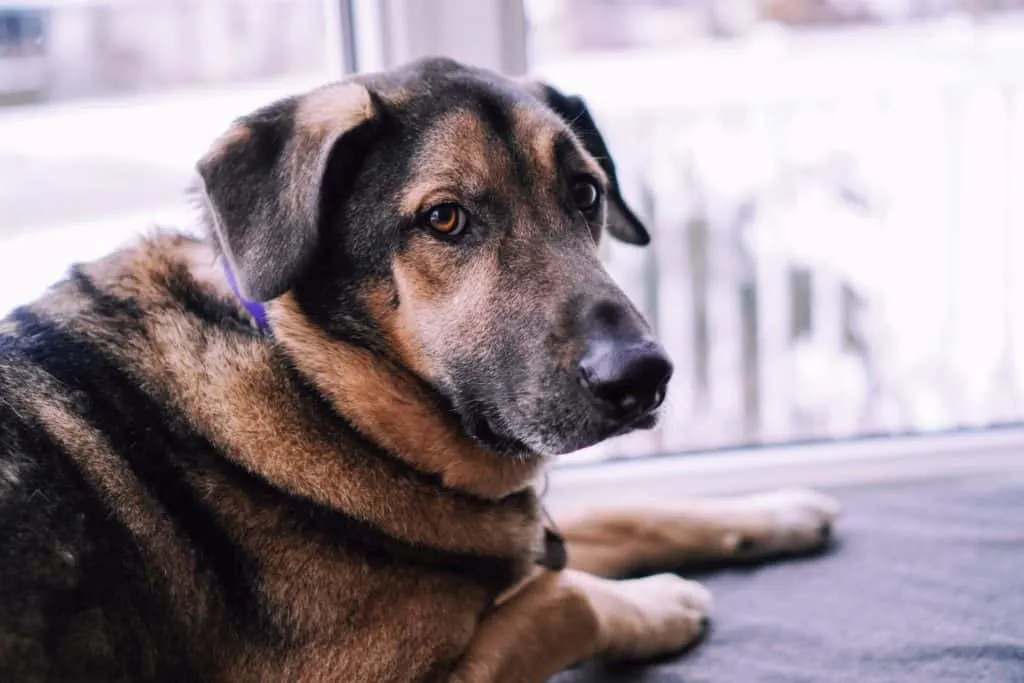
The science of a dog in heat
What if the dog’s heat cycle isn’t regular?
Irregularities in a dog’s heat cycle are much more normal than irregularities in a human’s menstrual cycle. Mother Nature works in weird ways.
Sure, you can write down the day she begins her heat cycle and the day you think it has ended all you like, but this won’t determine how long it will take for her next cycle to arrive.
Especially as German Shepherds are such large dogs, the time between cycles is mostly unpredictable.
As dogs can’t vocalize when they are going into heat, you must look out for the warning signs instead.
Some dogs might have a streak of cycles over a couple of years that are very regular, like clockwork. Others will go into heat randomly.
It’s important to note that if your German Shepherd has a litter, this will also affect the regularity of her future heat cycles.
There’s no point doing anything by the book – you kind of just have to (pardon the pun) go with the flow.
Generally speaking, your dog will develop some sort of regularity with her heat cycles when she is around 4 or 5 years old. Don’t hold us to that, as each dog is different!
What happens when my dog gets old?
Unlike humans, dogs don’t go through menopause. She will go in and out of the heat for the rest of her life.
The only difference is, that any form of regularity with previous heat cycles will go out of the window. Forget everything you thought you knew about how long each cycle lasts.
After around 6 years, your German Shepherd is likely to have shorter heat cycles. This is especially the case if she has been pregnant before.
If she becomes pregnant during the shorter heat cycles, this won’t change the health of the puppies compared to a longer heat cycle.
As with all mammals, female dogs will become less fertile as they age. This doesn’t mean their heat cycles will stop.
This is because German Shepherds are born with all the eggs they will need in their lifetime, so they won’t produce any more as they age.
Instead, the eggs will begin to age and die off if they haven’t been used, resulting in shorter heat cycles due to less fertility.
Can male German Shepherds go into heat?
Male German Shepherds do not have a uterus, therefore they cannot physically go into heat. Instead, they are sexually active and ready to go all year round. Alright for some.
It’s no surprise that some people might ask this question because male dogs can act really odd when a female is in heat.
This is purely because they can smell her cycle in a way that we cannot, and it causes them to want to mate and breed.
It doesn’t matter whether your male dog has been neutered or not, as they will still have the natural urges to mate.
They will go through some behavioral changes – especially if they live with a female unspayed dog – such as cheekiness, agitation, or even aggression.
They can become very protective of the female dog, even more so if they’re confused as to why she’s not producing a litter.
For small dogs, it’s somewhat easier to keep a male and female dog away from each other when she is in heat. This doesn’t mean they won’t try to get frisky, however.
For German Shepherds, it’ll be slightly trickier to keep them apart. These are big and strong dogs, after all.
This is why a lot of German Shepherd owners will opt to spay their female if they own both a male and a female dog.
Even if you have a male German Shepherd who begins to act strangely in the dog park or at the groomer’s, there’s a chance he is simply indicating the scent of a dog in heat.
This scent can linger, and German Shepherds are notorious for their heightened and impeccable senses.
Once the male dog can no longer smell the heat, he will immediately go back to his usual self.
Caring for a German Shepherd in heat
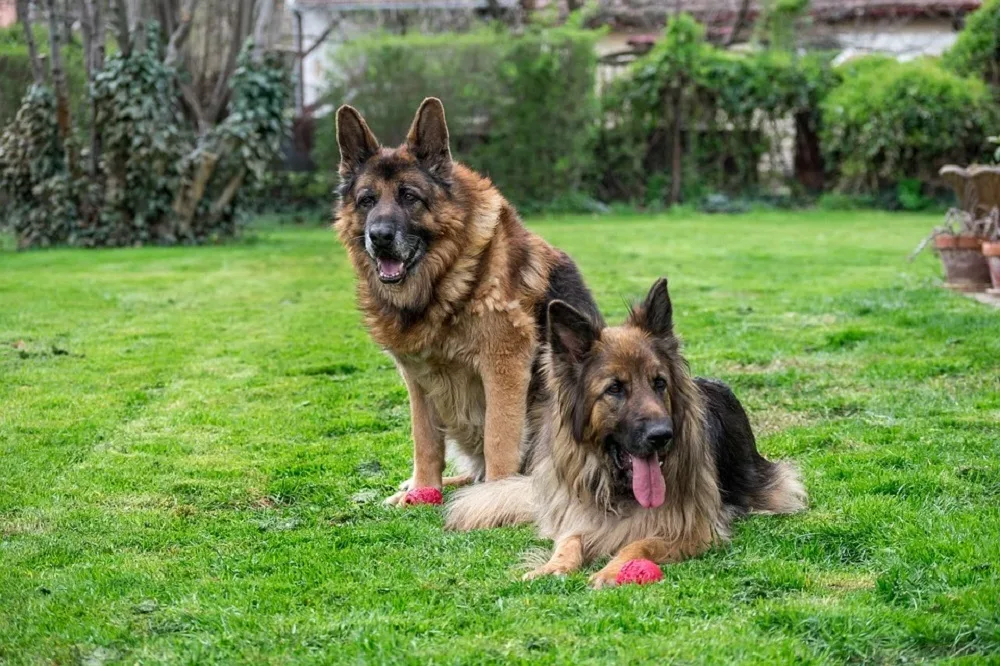
So, now you have got this far, you’re basically an expert in how the heat cycle works and what to look out for.
The next step is taking the necessary precautions to take care of your German Shepherd while she is in heat.
In this section of this guide, we will take you through some steps you can take to make your pooch’s cycle a little easier for everyone involved.
We will also give you some tips on how to handle a male German Shepherd who doesn’t know what to do with himself when he’s near a female in heat.
- Let Mother Nature do her thing
Fortunately for you, you mostly just have to leave your dog to do whatever she needs to do.
Mother Nature works in wonderful ways, and just because we can’t hear what the dog is thinking doesn’t mean she doesn’t know what to do.
From the moment she has her first heat cycle, her natural instincts will set in immediately.
This means that you don’t need to interfere too much with your dog while she is in heat.
It might seem a bit inhumane, especially if you have a uterus yourself, and you can empathize with the potential discomfort your dog is going through.
However, it’s much safer for you to allow Mother Nature to do her thing than to get involved and potentially stress your dog out.
- Give her some love
Being affectionate with your dog is the main bonus of owning a dog, and it’s not exactly a hardship. During her heat cycle, a female dog will become increasingly clingy and overly affectionate.
This is because her estrogen levels are rising, and she might be feeling some discomfort from the bloody discharge.
The best thing you can do for your German Shepherd who is in heat is to give her all the love in the world.
Some dogs might be aloof and dismissive, which is totally understandable. But for those who cling to their humans, you have to comfort her along this journey.
This is especially the case for dogs who are going through their first heat cycle at a young age.
Sure, Mother Nature will guide her through what she needs to do, but that doesn’t mean she’s not nervous about what’s happening.
Give her lots of cuddles and gentle words to reassure her that you’re right by her side.
This means that if she leaves behind a mess of bloody discharge, don’t yell or tell her off. She’s agitated and nervous enough as it is, so just clean up after her and move on with your day.
Speak only with a gentle voice to let her know that nothing is wrong.
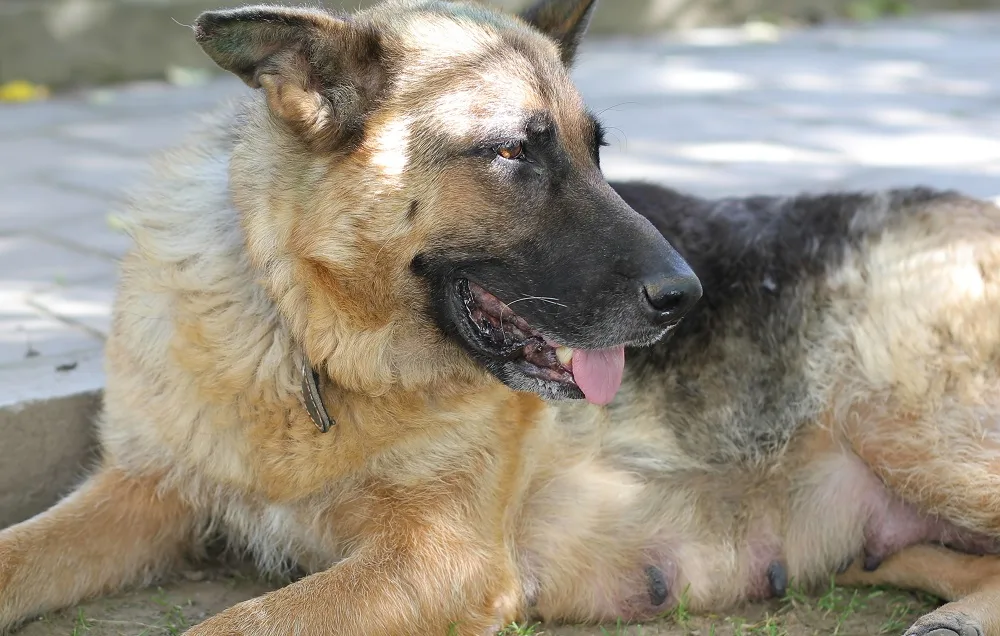
- Protect your home
Prevention is key when you’re dealing with a dog in heat. You should expect to see bloody discharge on your floor, cushions, bedding, and clothes for the next couple of weeks.
As we said, don’t scold or yell at your dog for it. Instead, there are some ways to prevent stains from appearing.
The easiest way to protect your furniture is to place old towels everywhere. If she likes to curl up on the couch, put some old towels underneath her so her blood won’t stain the couch.
The same goes for her dog bedding or if she likes to sleep in your bed.
For extra protection, look to invest in some reusable dog period pants. These are basically washable fabrics that can catch bloody discharge similar to human diapers or sanitary towels.
Not only will it protect your furniture and belongings from bloodstains, but the period pants can act as a diaper for excessive urination. It also means you don’t have to have towels everywhere!
While there are disposable dog period pants available, we recommend buying reusable washable ones for the benefit of the environment.
This goes without saying, but dog period pants won’t act as a contraceptive. When your dog enters the estrus stage and is ready to mate, she will simply find a way to rip the period pants off her body.
Nothing will stop her!
- Use your leash
It’s no secret that German Shepherds love to run and run and run on their walkies. However, when your female German Shepherd is in heat, it is wise to keep her on a leash at all times.
This means you should keep her on a leash at the beach, in a dog park, in a field, at the groomer’s, and even in your backyard if you live next to male dogs.
Remember, nothing will stop both male and female dogs from attempting to mate when she is in her heat cycle.
German Shepherds might not be small dogs that can squeeze through fences, but they can certainly fight their way through to get what they want.
- Isolate the dog
If your dog is no longer clingy and affectionate, and instead is more interested in mating with males, you might want to consider isolating her in another room.
This might seem cruel, but keeping her away from other dogs is the best way to prevent unwanted pregnancies.
Keeping her in another room means you don’t have to follow her around the house cleaning up after her, as it’s all in a confined space.
Also, she won’t be acting like herself during her heat cycle, which means she can easily become aggressive with other females in heat. Keeping her separate from other dogs during this time is a good idea.
However, don’t limit her social contact with humans.
German Shepherds are loyal and affectionate dogs who need love from their companions regardless of whether they’re in heat or not, so make sure to keep her preoccupied with some love!
You can keep her in a crate overnight if you want to control where she bleeds while you are asleep.
However, make sure to only keep her in this crate at night, otherwise, she might think you are punishing her.
- Go to the vet
If you are a new dog owner or even if you’re just feeling anxious about the state of your dog, you should take her to the vet.
The vet will be able to reassure you that her heat cycle is totally normal, and will probably give you tips on how to deal with it.
They can also discuss the option of spaying in the future if you are tired of dealing with her heat cycle.
- Get her spayed
If you’re really fed up with dealing with your dog in heat, or if she has had a litter and you don’t want her to go through another pregnancy, you should consider spaying her.
Spaying is a surgical procedure that involves removing the reproductive organs from the dog, which means she will no longer be able to have puppies or go into heat.
This is a common procedure that vets are experts in, and saves dog owners from a lot of future stresses and anxieties about unwanted pregnancies.
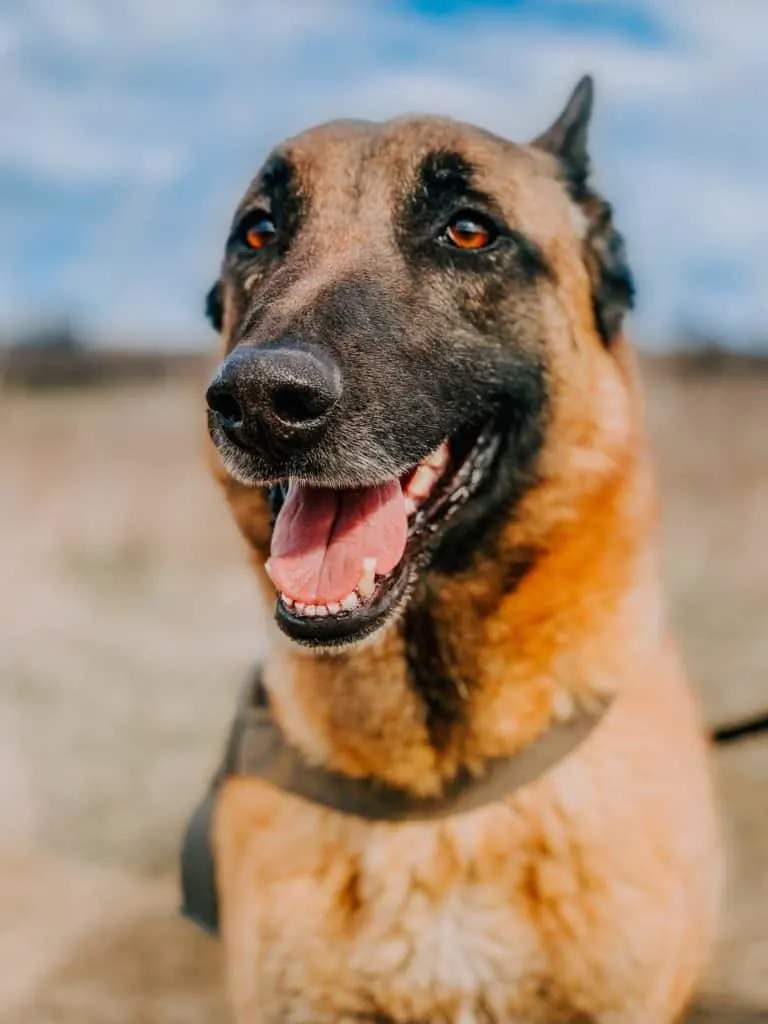
Caring for male German Shepherds during the heat cycle
While male German Shepherds won’t go through a heat cycle, they will still act very differently when they are around a female in heat.
If you have a male dog, you might want to read this section to get an idea of how to deal with him as his mating instincts are on high alert.
Remember that it doesn’t matter whether your male dog has been neutered or not – odds are that they’ve forgotten their “bits” don’t work anymore.
Keep him away
This seems obvious, but try to keep your male German Shepherd away from dogs in heat. This means that you should look to separate your male and female dogs in different rooms.
These are large breeds, which means that it can be hard to pull them apart when they are attempting to mate. (Also – remember to never disrupt the dogs while they are locked! Leave them alone.)
Not only will keeping your male dog away prevent unwanted pregnancies, but male dogs can get aggressive when they know a female is in heat.
They can become very protective over the female and will often growl, snarl, bark, or bite at other potential male suitors.
In the same way as a female dog, you can always keep your male dog in a crate overnight.
Just make sure not to put them in the crate sporadically during the day, as they might think they are being punished for something they cannot control.
Go to the vet
Each dog will react differently to a female in heat, so you can always take both him and your questions to the vet. This is a good idea if your dog acts aggressively when a female is in heat.
Your vet will tell you to distance the dog, and they might even give you some herbal remedies to distract the dog from smelling the scent of the heat.
Some herbal tinctures are designed to sedate dogs, which will calm down their aggression.
Distract him
You have to try and keep your male dog preoccupied when he is near a dog in heat.
This means that you should put him on a leash if a fellow dog owner says that their dog is in heat, or you can throw him a ball to distract him.
The same goes for if you have a male and female dog in your home.
It won’t be easy while all the hormones are flying around everywhere, but you can try to distract him from playing around with her by using toys and treats.
This is especially important during the proestrus stage. While she isn’t fertile at this point, sperm can be intact in her uterus for several days, which means she could potentially fall pregnant.
Plus, she won’t want to mate during this stage, so she could easily be aloof or aggressive towards a male dog who won’t leave her alone.
Doggy daycare
If you have tried all the previous tips and your male German Shepherd still isn’t leaving females in heat alone, you should consider sending him away on a little vacation!
Doggy daycares don’t accept females in heat due to the risk of unwanted pregnancies, so this is the best way to get your dog safely out of the house while your pooch finishes her heat cycle.
Some friends or family might be able to take care of your male dog for a couple of weeks, which means you can still visit him frequently.
Conclusion
So, there you have it! The ultimate guide to caring for a German Shepherd in heat.
As you now know, dealing with a dog in heat isn’t as stressful as you might think. Most of the time, you just have to allow Mother Nature to do her thing as your dog deals with it naturally.
Still, there are some great ways to make her heat cycle easier for everyone involved – including the female dog in question, male dogs, and humans.
Hopefully, this guide has given you some peace of mind as your pooch enters her next heat cycle!
























